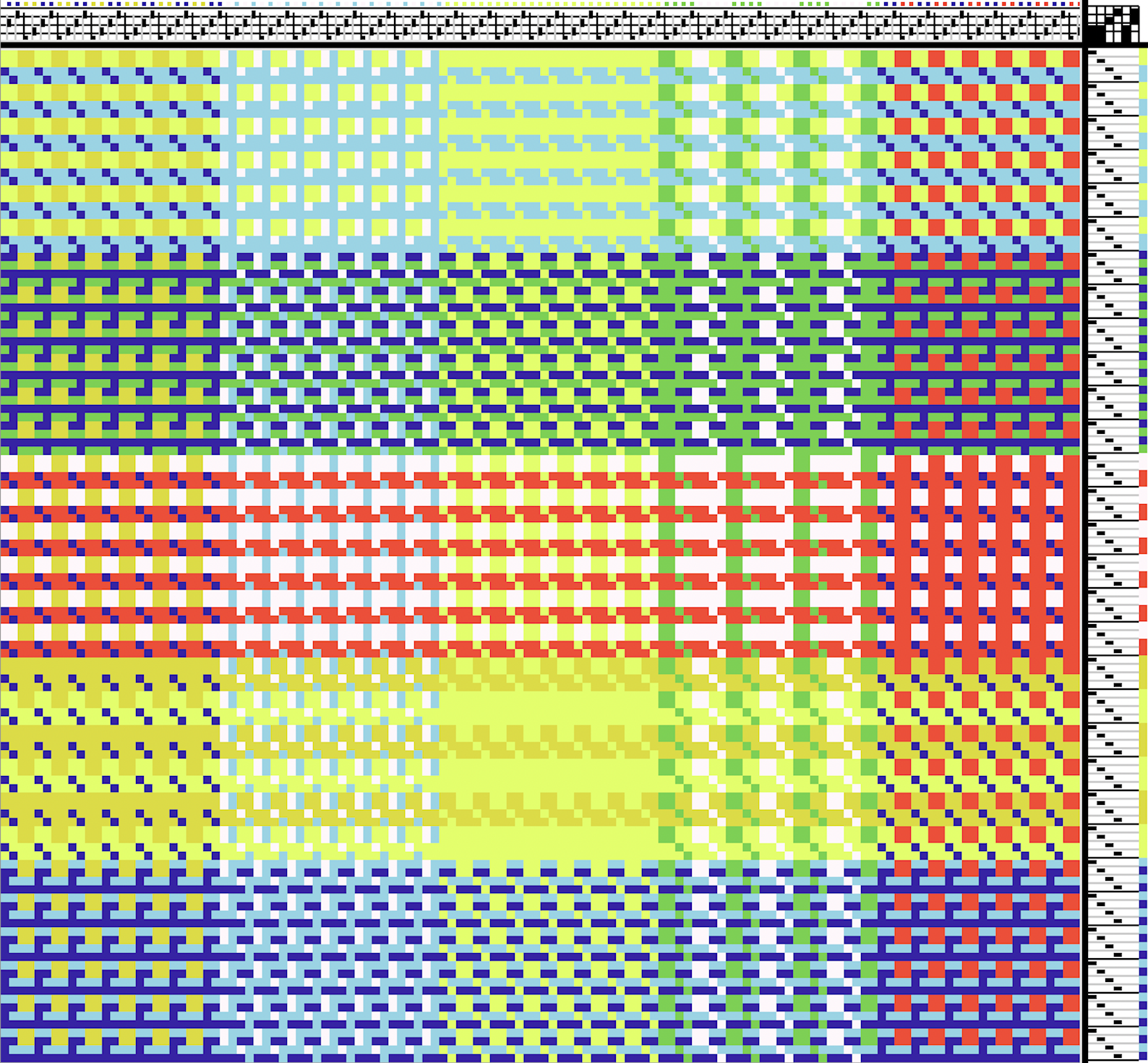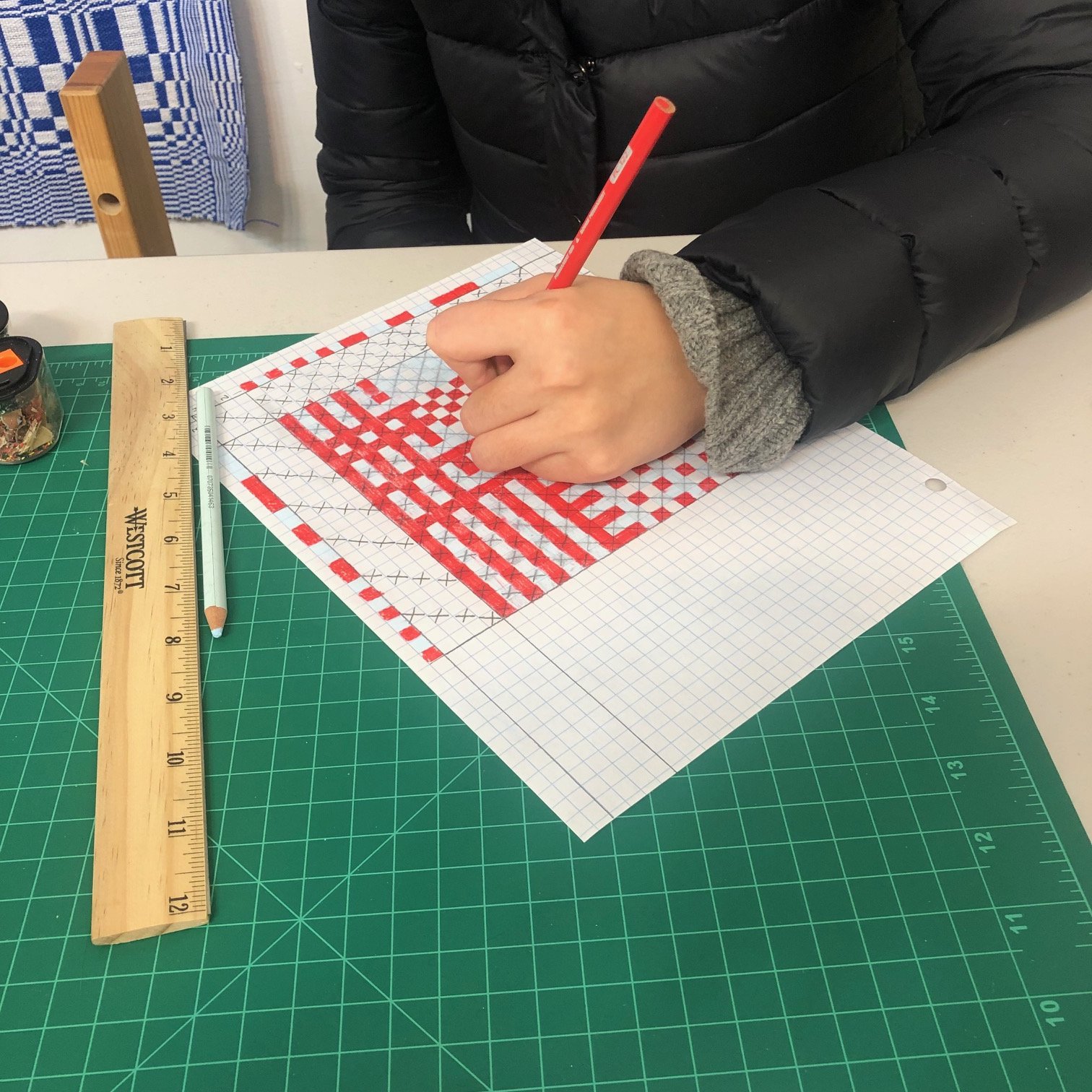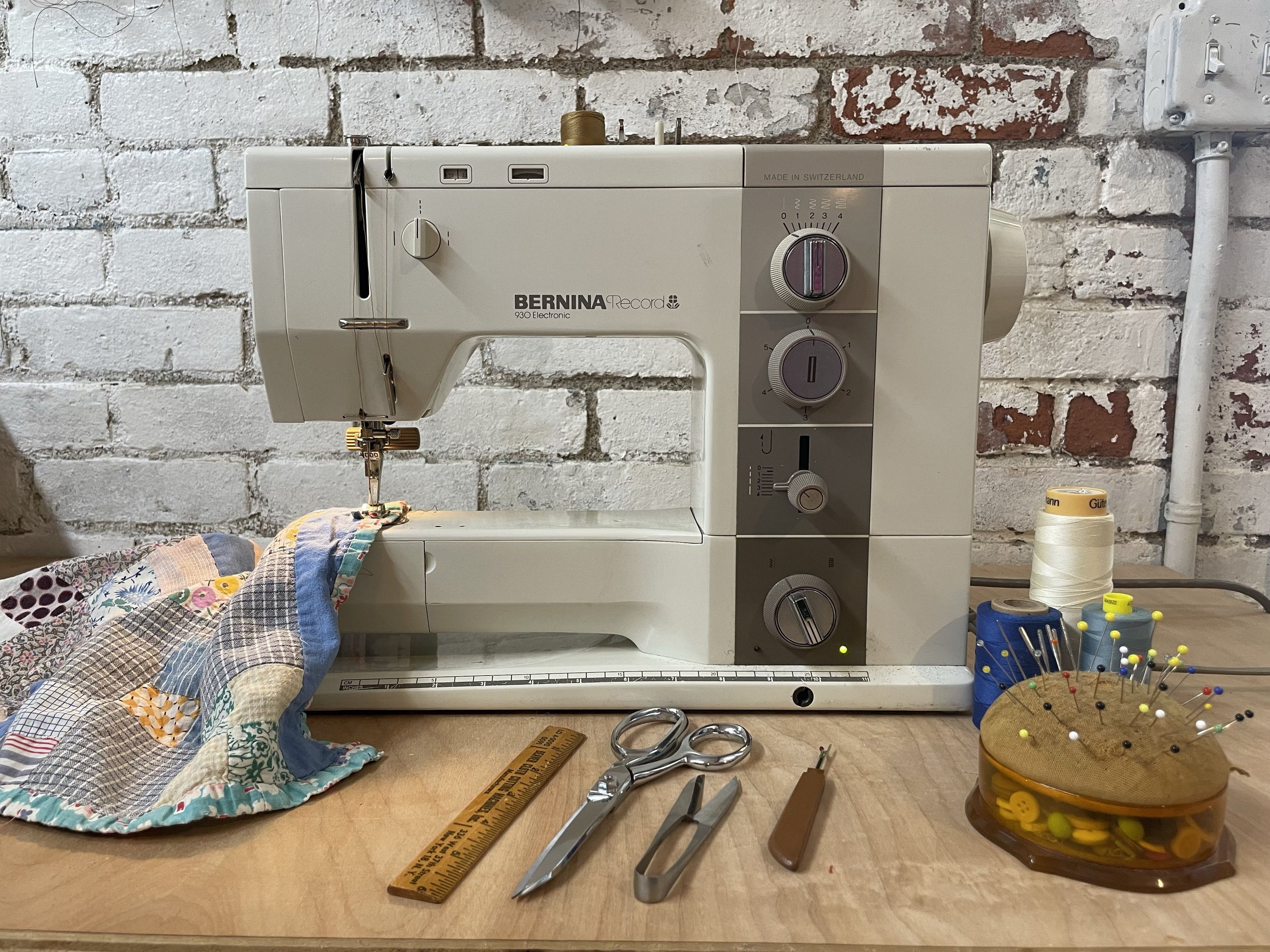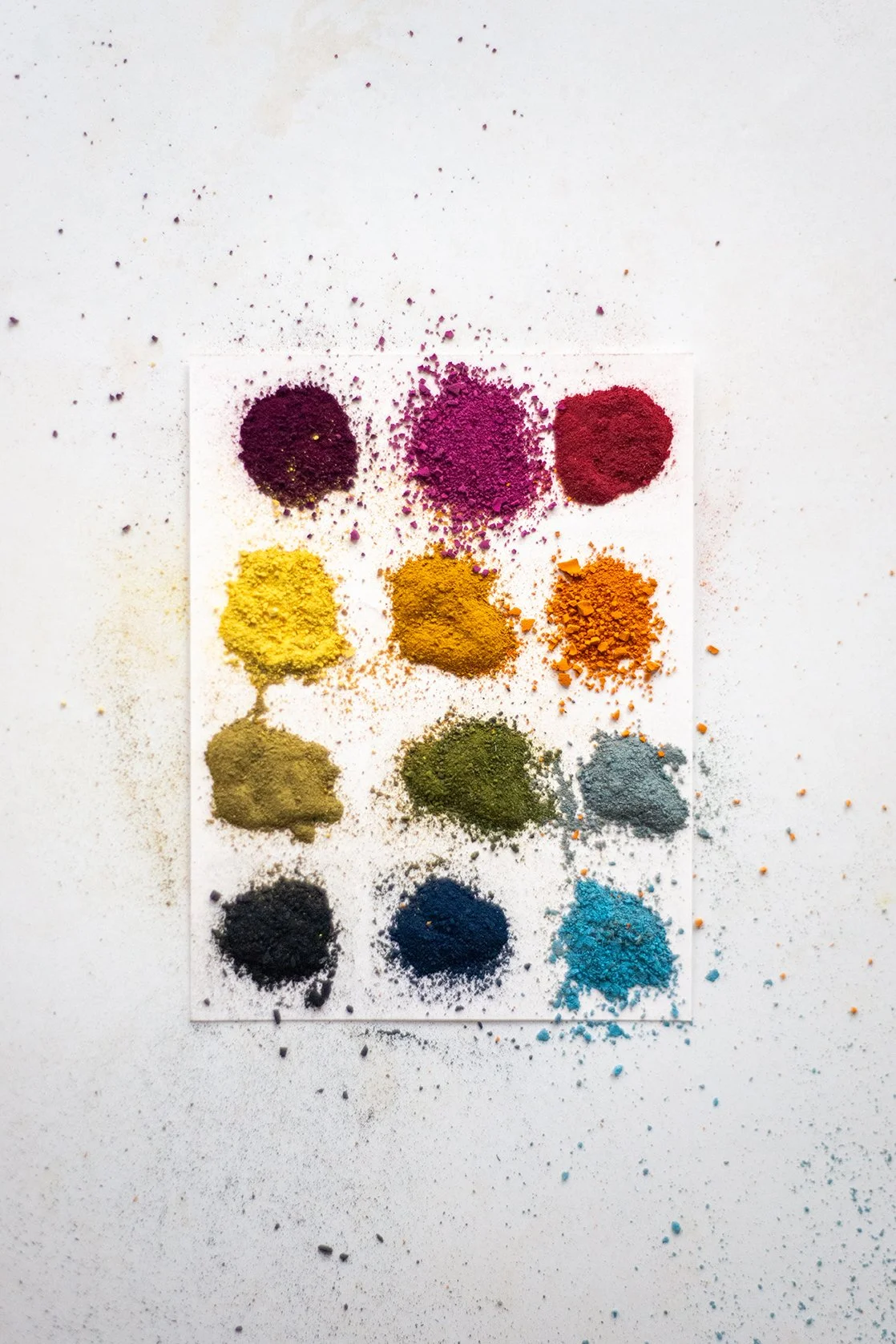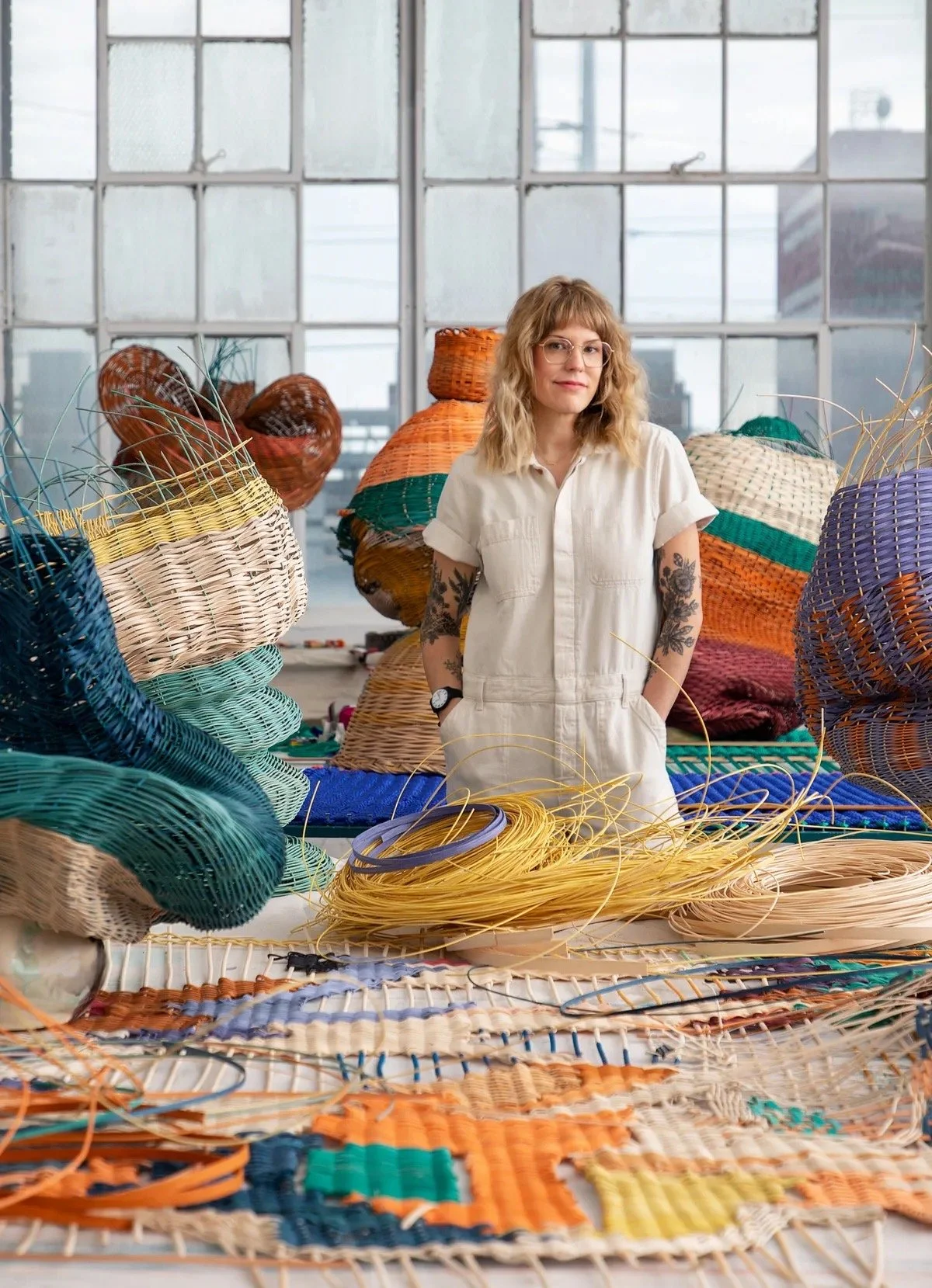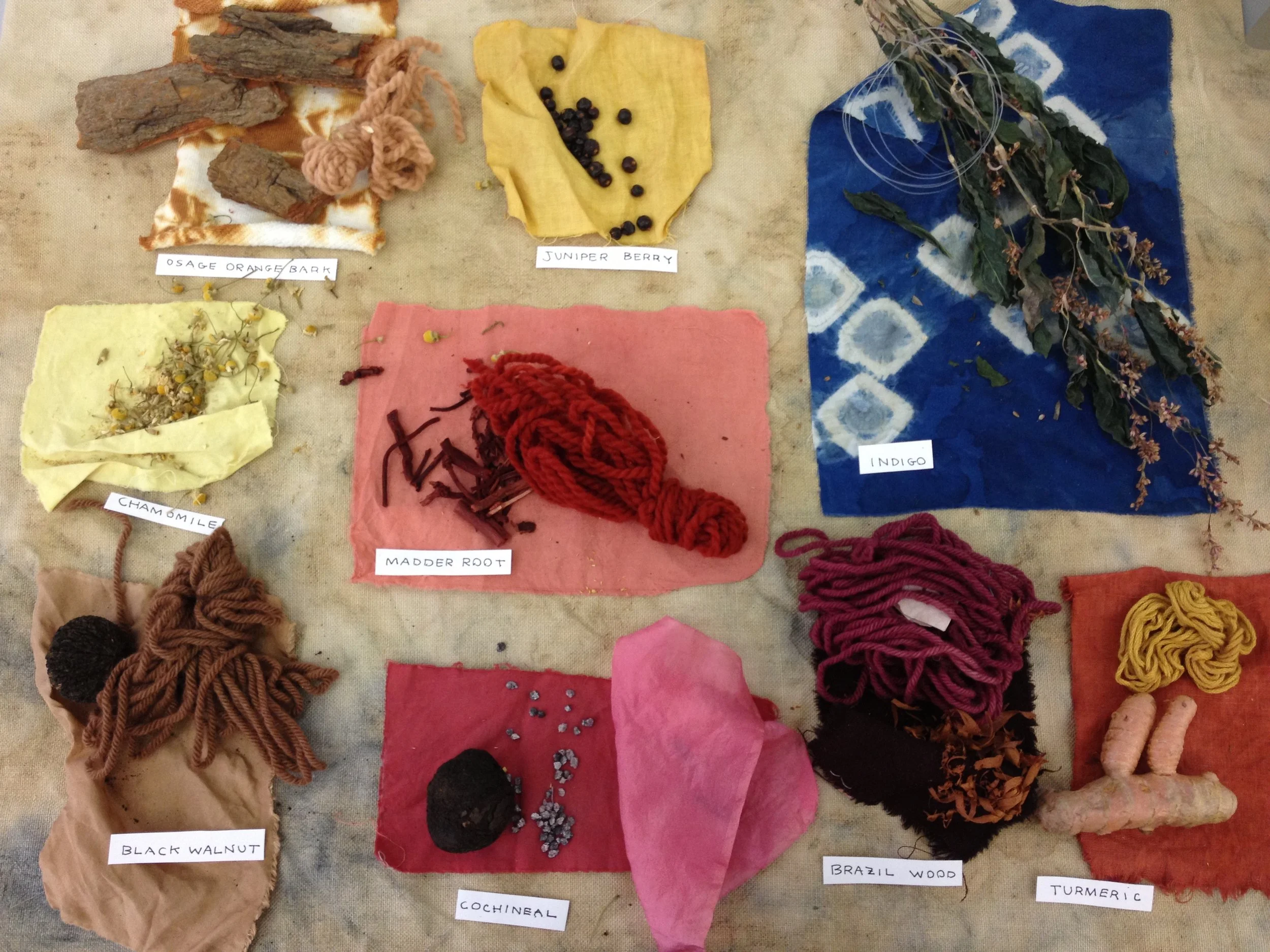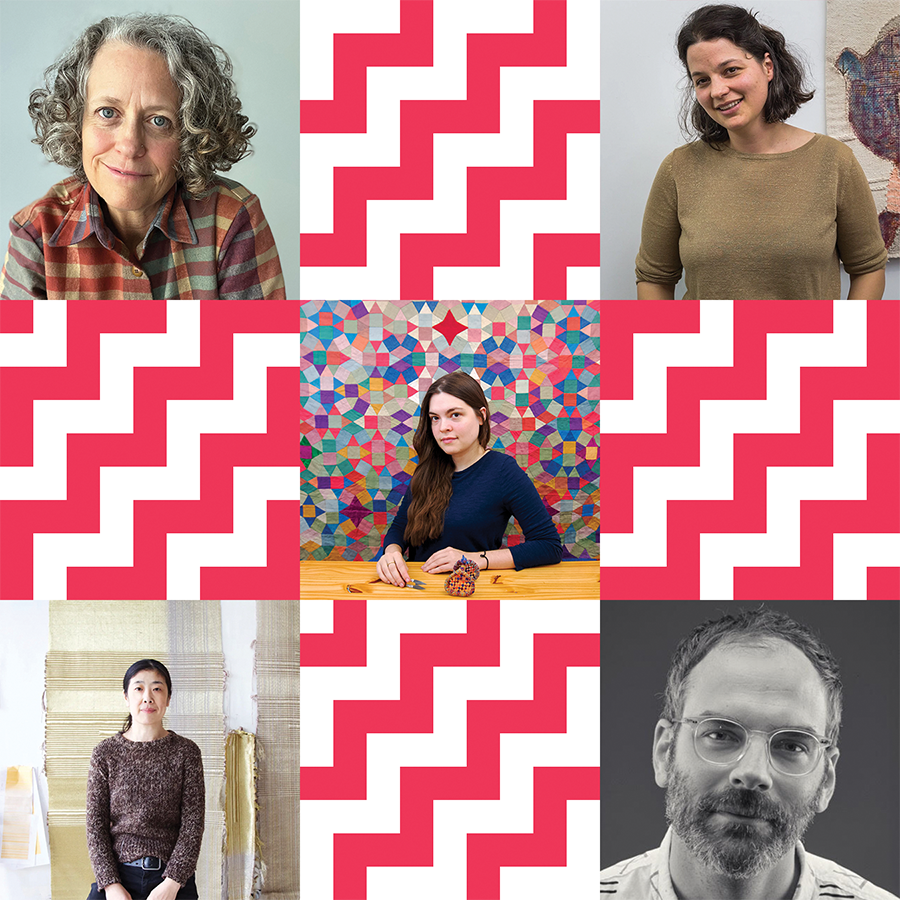
Class Descriptions
Introduction to Weaving
Introduction to Weaving begins with the basics of hand-weaving using a Schacht Wolf Pup 4-harness floor loom. On the first day, participants will learn how to wind a warp and set up their own looms. The second day will cover how to weave, basic weave structures such as plain weave, baskets, twills, and some tapestry techniques. The class will conclude with cutting off and finishing the edges of your weaving. This class can be taken multiple times with a different project variation each time. This class is designed for those new to weaving as well as for those with some experience but want a refresher. All materials and equipment are provided.
Level: Beginner / Advanced Beginner
Image: Zenona Darrow
Introduction to Weaving: Color
Introduction to Weaving: Color is a beginner / advanced beginner level class for all lovers of color! Explore and analyze different warp and weft color combinations through learning how to weave a traditional color gamp project. Each participant begins by selecting colors from a wide variety of mercerized and mercerized cotton threads, designing and winding a warp, and setting up their own 4-harness Schacht loom. The second day will cover how to weave. Basic weave structures will be taught such as plain weave, baskets, twills, and selected hand-manipulated weaves. The class will conclude with cutting off and finishing the edges of your weaving. This class is designed for those new to weaving as well as for those with some experience. All materials and equipment are provided.
Level: Beginner / Advanced Beginner
Image: Lauren Colbert
Introduction to Double Weave
Introduction to Double Weave is an intensive two-day class that covers the basics of weaving a double-layer cloth using a Schacht Wolf Pup 4-harness floor loom. On the first day, participants design their own multi-colored warps and be guided through setting up their own Schacht 4-harness floor loom. The second day will cover the basics of Double Weave including sampling from the following techniques: the book, the tube, the “x”, and the pillow. In the afternoon, the double weave pick-up technique will be introduced for those who wish to incorporate pictorial imagery into their multi-layer cloth. The session will conclude with cutting off and finishing the edges of the warp. This class is intended for those who have taken Introduction to Weaving or have other similar experience. All materials and equipment are provided.
Level: Advanced Beginner+
Weaving and Drafting Workshop
The Weaving and Drafting Workshop takes place over three sessions and cover drafting a basic woven sampler with pencil and graph paper, project planning, and setting up and weaving on a 4-harness Schacht floor loom. During the first session, participants will learn how to draft their own weave draft samplers from scratch. Project planning will also be covered more in depth, including various methods determining an EPI based on warp thread, choosing an appropriate reed size, and project sizing. Lastly, everyone will design their own composite threading pattern using A Handweaver’s Pattern Book to set up their looms the following week. The second session will cover dressing the loom, following a weave draft for threading, techniques for checking for mistakes along the way, tie-up variations, and beginning to weave. The final session will include weaving according to the drafted pattern as well approaches to deviating from the plan. The class will conclude with cutting off projects from the loom, finishing edges, and clean-up.
Level: Beginner+
Tapestry Weaving on a Frame Loom
Tapestry Weaving on a Frame Loom will cover the basics of weft-faced tapestry techniques as well as setting up and weaving on a Schacht tabletop frame loom. The frame loom is a simple, portable tool which can be used to make wall hangings or small textile squares to be pieced together into a larger project. This is the perfect class for the very beginner weaver. Participants will learn how to warp their loom and be introduced to plain weave as well as a variety of weaving techniques, such as clasped weft, slit weave, lace weaves, and hatching. The focus will be on weaving a larger project and more one-on-one feedback based on individual direction. The class will conclude with learning a hem stitch to finish off the weaving and studio clean-up. All materials and equipment are included, but feel free to bring any additional weft material that you would like to experiment with. All levels.
Image: Margot Becker
Warp Painting Weekend Intensive
Warp painting is an exciting way to explore color and surface design in weaving. In this class, we will explore different techniques for creating imagery and patterns through warp painting and discuss different types of paints and dyes according to the type of fiber and application. Each student will learn to set up their own loom (from front to back) with a pre-wound cotton warp and create a small piece based on their vision. This class is designed for students who are new to weaving on a shaft loom as well as those with some previous experience who want to explore new techniques. All levels.
Image: Isa Rodrigues
Introduction to Weave Drafting
Weave drafting is the pattern notation unique to weaving on a shaft-loom. In this introductory-level workshop, participants will learn how to read, modify, and create their own drafts from scratch. During the first session, participants will be shown examples of 4-harness drafts and be led through several drafting exercises intended to gain confidence with the basics. During the second session, participants will create an individualized sample blanket draft with color, and other common drafting scenarios will be discussed. This course is intended for people new to drafting that have some experience with weaving. Required materials: ¼” graph paper, 1/8” graph paper (optional), pencil / eraser, and colored drawing media. Recordings are available upon request.
Level: Beginner
Experimental Weave Drafting
Weave drafting is the pattern notation unique to weaving on a shaft-loom. In this three-session online class, participants build on what they learned in Introduction to Drafting as they are guided through a series of experimental exercises to generate their own weave drafts. This includes, creating your own Overshot draft from scratch using name drafting, generating an aperiodic draft with chance operations, and reverse engineering a weave draft from a drawdown. During the second session, the class will be joined by artist and educator, Etta Sandry, who will present on their experimental approach to weaving and drafting, followed by a Q & A. Basic instruction will be given on how to use the free online drafting software Treadl as well as Fiberworks, both as possible alternatives to drafting using pencil and graph paper. Participants are encouraged to download one or both in advance of the first session. Recordings are available upon request for those who are not able to make the scheduled classes.
Level: Advanced beginner / Intermediate
Image: Name drafting / Overshot
Introduction to Machine Sewing
Introduction to Machine Sewing is designed for absolute beginners who want to learn to sew! Learn the basics of machine sewing so you can incorporate sewing into your creative practice, have a handy skill, or go on to learn quilting and/or apparel construction! We will learn how to set up our machines, the parts and supplies, different stitches, basic troubleshooting as well as tips and techniques for new sewists. We will sew a simple tote bag with french seams with options to add patches or pockets. Students will leave with the foundational skills of machine sewing as well as an understanding of fabric construction and how to source and prepare materials. If you have some sewing experience but the machine still feels like a struggle, this is a good class to refresh your skills! Level: Beginner
Image: Anna Svoboda-Stel
Introduction to Quilt Making
Introduction to Quilt Making is a two-day, beginner friendly workshop where participants learn all steps in the quilt making process. Improvisational and traditional styles will emerge as you work through the patchwork piecing process on the first day to create your own unique quilt top. On the second day you’ll layer the pieced top with batting and backing creating a quilt sandwich for machine and/or hand quilting. As a last finishing step, you’ll learn to secure the edges of your quilt by attaching a binding. All levels.
Prerequisite: Basic sewing machine skills: know how to wind a bobbin and maintain a seam allowance.
Image: Susan Chiappini
Cyanotype Printing on Paper and Fabric
Cyanotype Printing on Paper and Fabric introduces the basics of how to create beautiful hand-made blueprints on paper and fabric using camera-less photography. Cyanotype is one of the oldest alternative photographic processes that was developed in 1852. It uses non-toxic chemicals, ferric ammonium citrate and potassium ferricyanide to create a UV sensitive solution which produces vibrant Prussian blue colors. During the first part of class, participants will make photograms on paper, using small personal objects, drawings on acetate, and plants and leaves from nature. After a short lunch break, participants will create a larger photogram on fabric, as well as be introduced to an optional toning technique for those wanting to experiment with different color hues. All levels.
Image: Viktorsha Uliyanova
From Plant to Pigment: Introduction to Lake Pigments
For those of us seeking sustainability and ecological connection in our creative practices, the chemically pure colors of today’s art suppliers are very far removed from nature. Join Natalie Stopka, author of From Plant to Pigment, for an introduction to lake pigments. This process of transmuting fragile botanical dyes to durable pigments extends the artistic applications of dye colors into expanded media including paint, ink, and pastel. Inspired by the history and craft of color-making, Natalie will share her master recipe for creating handmade, homegrown, and local pigments. Participants will leave with three different pigment colors, an overview of paint-making, and the knowledge to continue exploring lake pigments in their own studios. All levels.
Image: Natalie Stopka
Sculptural Basketry
Join artist Dee Clements for a weekend workshop exploring sculptural 3D weaving with basketry reed. In this class, participants will learn and apply basket weaving techniques to create three-dimensional forms, structures, and vessels. We will begin by weaving a lashed round base and practicing different weaving techniques, introducing plain and dyed colored reeds to explore how these techniques can create various patterns. Additionally, we will investigate form and structure, examining sculptural basket work from both historical and contemporary perspectives. Participants will have the opportunity to create small-scale projects, either using molds and formers or working freehand. The emphasis will be on using basketry techniques to explore pattern, form, structure, and sculptural ideas. All levels.
Image: Dee Clements
Introduction to Natural Dyeing
This one-day workshop delves into beautiful, accessible, and sustainable natural dyes for both protein and cellulose fibers. Starting with best practices of fiber preparation, we’ll then extract color for 24 swatches in a rainbow of hues. This process will demystify mordants and address the all-important question of longevity! All fibers and dyes will be provided for a mini swatch library. Participants are welcome to bring one additional pre-washed garment, skein, or yard of natural fiber for a personal project. We’ll discuss safety considerations, foraging ethics, and the colorful history of natural dye use. Participants are asked to wear studio-safe clothing; we might get messy!
Level: All levels
Image: Natalie Stopka
Natural Dyeing Weekend Intensive
In this workshop, participants will learn the foundations of working with natural color on textiles, while discussing natural dye materials' history, chemistry, and sustainability. Over the two days, participants will learn the basics of mordanting, dye extraction, dyeing techniques, color modifications, and setting up an indigo vat, to collaboratively create a natural dye color sampler. We will work with natural dyes with a rich history of use in North America, such as madder, osage orange, black walnut, and the magical indigo. Other options for natural dye materials, such as food waste, invasive plants and other, will also be discussed for future exploration. All materials will be included, however, students are encouraged to bring small quantities of textile materials/garments for independent exploration.
Level: All levels
Image: Isa Rodrigues
Artist Lecture Series: Weaving in Contemporary Art (Winter / Online)
This 5-session series presents weekly lectures by artists and designers that work with weaving as a primary medium in their practice. Collectively, their work spans computer-assisted and industrial jacquard weaving, tapestry weaving, off-loom weaving, hand-weaving on a harness floor loom, sculpture, and installation. Each week a different speaker has been invited to discuss the concepts, process, techniques, and materiality, that are specific to what they do. This is intended to be an opportunity to connect with fellow weavers (and weaving admirers) in a virtual setting. Each presentation will be followed by a brief Q&A. Supplemental reading materials and online links will be provided in advance of each week to provide background and context for each artist. Recordings will be available for a limited time following each weekly lecture for those who are not able to attend live.
2026 Presenters: Josh Faught, Christina Forrer, Em Kettner, Hiroko Takeda, Susie Taylor
2025 Presenters: Paolo Arao, Liz Collins, Craftwork, kg, Emily Winter
2024 Presenters: Diedrick Brackens, Dee Clements, Christy Matson, Jovencio de la Paz, Erin M. Riley




